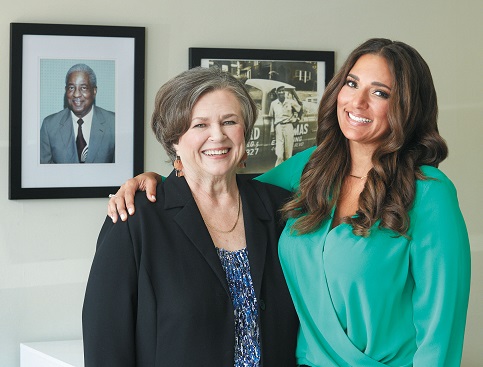Rowing in the Same Direction

By: Will Jones
“My parents named both me and my brother with ‘R’ names,” says Raina Walton, president, RT Thomas Insurance in St. Louis, Missouri. “He did that in case we wanted to take over the agency—that was his perpetuation plan.”
When Walton’s father passed away in 1998, the family business transferred to the two siblings. However, in 2016 the pair decided to split the company and book of business between them to each focus on their respective niches.
Walton, whose agency is focused primarily on personal lines with the potential to branch into commercial, is now focused on growing the book, streamlining processes and increasing the value of RT Thomas Insurance to prepare for a transition, whenever that may occur.
“I haven’t started marketing it out, looking at mergers or even decided if the sale will be internal or external,” Walton says. “But one thing that I do need to have in place is an immediate short-term succession plan.”
The need for a succession plan recently hit home for Walton when the office faced a coronavirus scare that meant all the staff needed to be tested. Despite being prepared for the pandemic from a technology and operations perspective, “I thought, ‘Oh my goodness, what if we all test positive at the same time?’ It was a bit of a reality check,” Walton says.
“Since becoming the sole owner of the agency, my goal has been to build an agency that is not solely reliant upon me for growth and functionality,” she says. “A lot of small agency owners don’t make it easier on themselves by neglecting to transfer responsibilities to their employees.”
Succession Success
Apportioning responsibility among staff to perpetuate is not easy and agency owners must recognize it’s a long trek. A marathon, not a sprint. A process versus an event. “Unfortunately, a lot of people think about perpetuating their agency well after the horse has bolted,” says Steven Germundson, partner at OPTIS Partners and a senior-level consultant to owners of independent agencies and brokerages.
Despite the uncertainty it has caused, the coronavirus pandemic shouldn’t affect perpetuation plans. “Even if we shut down the country for a year and it takes another year to get a vaccine, the economy will have hurt for two years,” explains Germundson. “It takes a lot longer than that to perpetuate an agency.”
“The coronavirus has not affected our agency at all,” confirms Doug Smart, president, Smart Agency in Abeline, Kansas, who began to purchase the agency in 1991 and spent the next 10 years buying the owner out. Fast forward to 2020 and Smart is in the seventh year of a similar internal transition that will result in Kyle Becker, vice president of Smart Insurance, becoming the owner.
“I got to the point where I needed another producer,” Smart recalls. “Kyle was a car salesman at the time and wouldn’t leave me alone. He was in my office every week trying to sell me a car. That was when I realized that he had what it takes.”
Once Smart had identified his successor and Becker agreed, the next step was to structure a deal. After speaking to a few banks, the most logical step was to invest in Becker and give him 25% of the company with a 10-year ownership pay-back plan, which he is paying in the form of a dividend that the agency pays him every month and Becker uses to purchase stock from Smart.
“At the end of the 10 years, he will be paying me based on a factor of gross commissions,” Smart says. “Hopefully, those commissions will be significantly higher than when we started the process, which means I’ll get a positive return on investment.”
For Becker, the opportunity to own the agency is more than purely financial. “Doug is my mentor. He’s the guy that I go to and say, ‘Hey, I’m thinking about this. What are your thoughts?’ We discuss everything,” he says. “The hardest thing for any owner is being around during the perpetuation process—and it’s definitely a process. We don’t agree on everything, but Doug has been a man of his word. He’s let me have a few wins, as well as make some mistakes.”
Look Inside
“To determine the strategy for how you perpetuate your agency, there has to be some self-reflection to figure out where you’re at, how long you want to be part of the business and what that looks like for you,” says Jim King, owner of Balasa Dinverno Foltz, an independent private wealth management firm based in Chicago. “Agency owners need to figure out if they’re sticking around for another five to 10 years or if they’re looking to get out and retire tomorrow. And then they need to be honest with themselves about whether they’re willing to work for someone else.”
“Internal perpetuations are a lot less common nowadays because of the figures being offered by private equity firms, and it’s really easy for agency owners to get lost in the dollar signs,” King continues. “That’s why self-reflection is so important. Agency owners who are genuine about wanting to take care of their employees and clients need to be sure that an external buyer shares their culture.”
For Smart and Becker, there was no such worry. “Smart insurance has always been community-minded,” Becker says. “When we perpetuated, Doug wanted a community-minded person to take this over and would continue our core values and take care of our people.”
“We could walk out the door tomorrow and sell this agency for a million dollars more than what Kyle is going to be paying for it, but that doesn’t do my community, my customers and my employees any good,” Smart adds.
 Perpetual Growth
Perpetual Growth
Without a succession plan in place, the best thing an agency can do to perpetuate is to focus on constantly and consistently growing their business, which rings true regardless of what stage an agency is at in their perpetuation plan.
“It doesn’t have to be massive or rapid growth, but just steadily evolving, growing and developing business,” Germundson says. “In other words, you have to run the business like a business.”
Since becoming the owner of RT Thomas Insurance four years ago, Walton is focused on just that, “transforming a dinosaur agency into the agency that we are now,” she says. Specifically, technology and agency culture are two of the items at the top of her priority list, which are both linked to attracting the talent that will take the agency forward in the years to come.
“I’ve been leveraging a lot of technology and using virtual assistants to push a lot of the repetitive time-consuming work outside of the agency and streamline our operations to maximize profitability,” Walton says. “If you don’t have these measures in place, you’re not going to be able to hire and retain the younger generations.”
Two-thirds of active and passive job seekers said that a diverse workforce is an important factor when evaluating companies and job offers, according to a survey by Glassdoor. With millennials and Generation Z emerging as both the largest and most diverse generations in the U.S., diversity and inclusion needs to be a central tenet to perpetuation strategies.
“Many agency owners discount millennials and Generation Z as potential buyers,” Walton (pictured above, right, alongside her mother) explains. “Younger generations are seeking career paths that lead to autonomy and ownership. Although they are attracted to the IA model, starting a scratch agency is certainly not for everyone. They need to be able to see your business as their future. They need to say, ‘Wow, this is an established business that’s ready to go. I could get a loan and purchase this.'”
“However, if they walk into your office and see a lack of diversity, employees using politically incorrect terms and antiquated operating systems then you may be turning off a whole pool of people who could be interested in purchasing your company,” she says. “If they don’t even want to work there, they certainly don’t want to purchase it.”
Will Jones is IA managing editor.
ESOP’s FablesWhen a perpetuation plan is not put in place early enough, it can cause problems for the company’s incumbent owners, staff and clients, as well as the prospective buyers. In 2005, Bruce Christensen, CEO, Christensen Group Insurance in Eden Prairie, Minnesota, and three other members of the brokerage were looking for a way to buy out the current owners, one of which included Christensen’s father and the company founder. When they looked closer at the math and the timeline for how to finance a deal, an internal perpetuation did not seem like the best approach because of the huge numbers and time needed to execute a deal. The plan they landed on was an Employee Stock Ownership Plan (ESOP), which resulted in the owners selling 100% of the business to the ESOP. When the ESOP was first put in place, the agency had 50 employees. Now, they’re at 150. Further, after several years of acquisition, Christensen Group Insurance is now consolidating and focusing on onboarding accounts, culturally integrating acquired companies and creating uniform systems and processes. In 2020, the company placed 85th on Business Insurance’s Top 100 Brokers list. “The ESOP is a tremendous structure,” says Charlie Christensen, CFO, the Christensen Group Insurance. “No one gets a different deal—whether you’re the receptionist or the CEO—everyone gets the same. I’m very bullish on the structure, particularly in an economic environment that has greater and greater wealth disparity. This is the capitalist solution to solving wealth inequality.” The caveat to the ESOP structure is that it relies on good recruitment and strong leadership. “Because every employee we hire becomes a partner under the ESOP, it puts a lot of pressure on making sure we’re bringing the right people,” Christensen says. “It’s been a great financial and cultural tool and our financial results reflect how successful it’s been.” “We don’t have a massive concentration of ownership where one or two people own 60% of it,” he adds. “It’s constant perpetuation.” |










